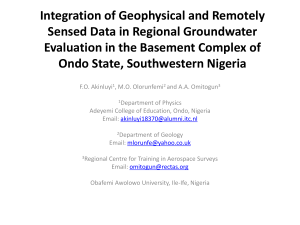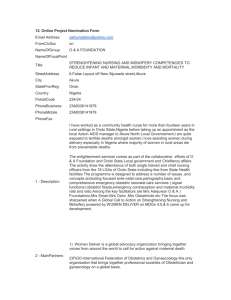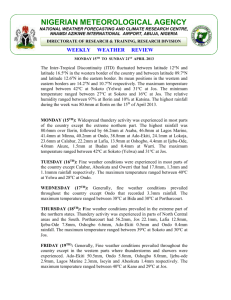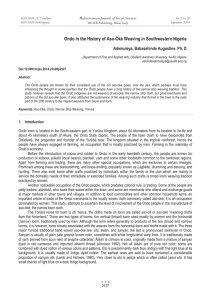Document 10465684
advertisement
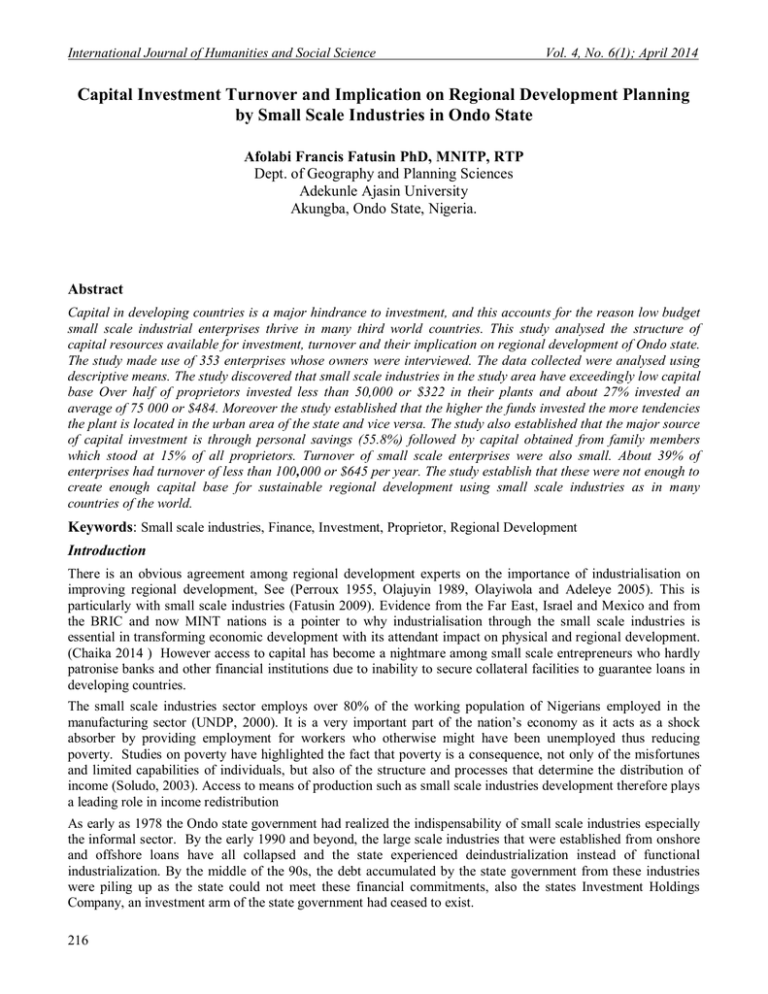
International Journal of Humanities and Social Science Vol. 4, No. 6(1); April 2014 Capital Investment Turnover and Implication on Regional Development Planning by Small Scale Industries in Ondo State Afolabi Francis Fatusin PhD, MNITP, RTP Dept. of Geography and Planning Sciences Adekunle Ajasin University Akungba, Ondo State, Nigeria. Abstract Capital in developing countries is a major hindrance to investment, and this accounts for the reason low budget small scale industrial enterprises thrive in many third world countries. This study analysed the structure of capital resources available for investment, turnover and their implication on regional development of Ondo state. The study made use of 353 enterprises whose owners were interviewed. The data collected were analysed using descriptive means. The study discovered that small scale industries in the study area have exceedingly low capital base Over half of proprietors invested less than 50,000 or $322 in their plants and about 27% invested an average of 75 000 or $484. Moreover the study established that the higher the funds invested the more tendencies the plant is located in the urban area of the state and vice versa. The study also established that the major source of capital investment is through personal savings (55.8%) followed by capital obtained from family members which stood at 15% of all proprietors. Turnover of small scale enterprises were also small. About 39% of enterprises had turnover of less than 100,000 or $645 per year. The study establish that these were not enough to create enough capital base for sustainable regional development using small scale industries as in many countries of the world. Keywords: Small scale industries, Finance, Investment, Proprietor, Regional Development Introduction There is an obvious agreement among regional development experts on the importance of industrialisation on improving regional development, See (Perroux 1955, Olajuyin 1989, Olayiwola and Adeleye 2005). This is particularly with small scale industries (Fatusin 2009). Evidence from the Far East, Israel and Mexico and from the BRIC and now MINT nations is a pointer to why industrialisation through the small scale industries is essential in transforming economic development with its attendant impact on physical and regional development. (Chaika 2014 ) However access to capital has become a nightmare among small scale entrepreneurs who hardly patronise banks and other financial institutions due to inability to secure collateral facilities to guarantee loans in developing countries. The small scale industries sector employs over 80% of the working population of Nigerians employed in the manufacturing sector (UNDP, 2000). It is a very important part of the nation’s economy as it acts as a shock absorber by providing employment for workers who otherwise might have been unemployed thus reducing poverty. Studies on poverty have highlighted the fact that poverty is a consequence, not only of the misfortunes and limited capabilities of individuals, but also of the structure and processes that determine the distribution of income (Soludo, 2003). Access to means of production such as small scale industries development therefore plays a leading role in income redistribution As early as 1978 the Ondo state government had realized the indispensability of small scale industries especially the informal sector. By the early 1990 and beyond, the large scale industries that were established from onshore and offshore loans have all collapsed and the state experienced deindustrialization instead of functional industrialization. By the middle of the 90s, the debt accumulated by the state government from these industries were piling up as the state could not meet these financial commitments, also the states Investment Holdings Company, an investment arm of the state government had ceased to exist. 216 © Center for Promoting Ideas, USA www.ijhssnet.com In order to ease access to long term capital for investment the government came out with many credit schemes. Government later established the small scale Industrial credit scheme to channel loans and other financial assistance to these mostly private enterprises. The result was that, out of the 1,873 registered industrial enterprises in the state in 1998; over 1,293 or 70% are in the small scale category, which employ between 1-9 people. In 1996, the State Government entered into agreement with the UNDP under a joint venture to pull resource together to provide loans to the SSI. The State Government was expected to make a counterpart contribution of #1.4 million to the UNDP and draw #6.7 million to assist small scale industries programme in the state. A total of 39 projects had been assisted in the procurement of equipment in such areas as garri processing, palm oil processing and constructional blocks making firms. However years after the government established these schemes, access to capital for investment have even become more difficult and has stiffens new investments. This has reduced the ability of this industrial sub group to grow and contribute in sustainable ways to regional development. This study analyses the less developed structure of capital and its regional characteristics in Ondo State of Nigeria. Literature Capital, a Global Problem Every business, whether small or big is affected by access to capital which determines, size, profitability and stature. In fact, Perrouxes (1955) idea of propulsive and dominant industry, to engender regional development requires considerable capital which more often than not is lacking in developing countries. According to Harris and Robinson (2006), the rates of business failures are affected by factors such as type, ownership, size of the business and expertise of the owner, the most common causes he claimed however ts inadequate financing. Esubiyi (1992) in his work ‘Ensuring Survival of Small-Scale Industries’, advocated that the key problem facing most small scale industries is lack of finance for the establishment of new industries or to carry out – expansion plans, the inability to attract financial facilities has stifled the growth of this sub sector, commercial and merchant banks which were expected to be the launch-pad for development of small scale industries, through the provision of loans, have failed to give adequate support to this sub sector. Stiff collateral security demanded by banks often means that small scale industrialists are unable to meet these provisions consequently losing the chance to obtain loans. In addition, high interest rates charged on loans have scared off potential small-scale entrepreneurs. Banks, on their own part according to CBN(2011) have argued that they are discouraged to lend to this subsector since many potential and existing small and medium scale entrepreneurs draw up feasibility report that are not viable, lack managerial-skills and do not maintain adequate financial or accounting records about their businesses. The banks claim that where loans are granted, they are usually directed to other unproductive uses. Thus, this sub sector is regarded as a high risk area for lending purpose, due to the high percentage of default on repayment of loans. Overall, there has been a tot of distrust – between small-scale industrialists and the banks. However, he suggested that banks should give more encouragement to small scale entrepreneurs by supporting cooperating and being fully involved in financing men and women who bring forth good ideas through viable feasible studies. Ajiebefun and Daramola (2003) in their study of the growth trends in small scale industry in Nigeria opined that the growth rate of this industries subgroup has reduced. They figured out the epileptic power supply in Nigeria, coupled with poor technology and poor access to loans as being responsible for this. The Inadequacy of infrastructural facilities such as electricity, water supply, communication facilities, security services, etc have been inhibiting investment in the small scale industrial sector in Nigeria. This belief is further reinforced in potential investor that one has to be opulent to succeed as a businessman. For example, at added costs, the industrialist or potential investor must think of providing “stand by” fuel or gas powered generator, make boreholes for industrial and domestic use, look for land to lease and construct roads (or if need be bridge) that would link up with the major roads – all at exorbitant cost. Invariably, small industrial units, due to huge capital requirement, always find it very difficult to compete keenly with importers or multinationals operating in the country who more often than not are accessible to global investible funds. Most of them find it difficult to penetrate domestic markets not to talk of overseas markets because they find it difficult to sell at a price that would gear the maximization of the consumer’s purchasing power. 217 International Journal of Humanities and Social Science Vol. 4, No. 6(1); April 2014 The problems confronting small scale industries in difference countries of the world are quite similar for instance in Korea according to the United Nations, the vast majority of small mid medium industries in the Republic of Korea are privately owned and they experience considerable difficulty in securing access to capital markets. As a result they are heavily dependent upon more informal sources of financing, such as private moneylenders, also known as the “crib market”, where interest rates are exorbitant. This problem is aggravated by the fact that Korean banks tend to make loans largely on the basis of the borrowers collateral, without considering the validity of the purpose for which the loan is desired. However, the government has established measures to facilitate financial assistance for small and medium industries. In Philippine, among the problem facing small and medium industries include inadequate production techniques, and procedures, raw material, quality assessment, financing, lack of skilled man-power, and heavy competition. In broad terms, the problems of Thailand’s small and medium industries are similar to those of their counterparts in other developing countries. However, one of the, most important constraints is lack of finance. In Malaysia, according to Shankar, Mohamed and Jayarama, (2011) the main problems that hinder the growth of this subsector include the following: Poor Access to the loan schemes of various financial institutions and commercial banks since most small and medium industries are unable to provide the necessity collateral, poor access to technical assistance, weak marketing know-how and support for small scale industries. Moreover many firms are normally content with supplying the traditional local markets, because they lack foreign market information and capital. Others include non availability of industrial land and factory space. Where available they are generally too costly and beyond the reach of most small and medium industries (UNDP, 2002). While small industries have grown in some countries, however, rarely are the enterprises in developing countries adequately organised to perform such tasks as identifying technological needs, defining projects, screening alternative sources, contracting developed – countries’ small enterprise and negotiating projects. These problems apply as well to large local firms, but local small enterprises have fewer skills than local large firms. Materials and Method Ondo State of Nigeria is one of the seven states created on 3rd February 1976. It was carved out of the former Western State. The state covered the total area of the former Ondo Province, which was part of the western region created in 1915 with Akure as the provincial headquarters. Ondo State took off formally on 1st April 1976, consisting of the nine administrative divisions of the former Western State (Ondo Ministry of Information and Culture, 1979). These nine divisions then were Akoko. Akure, Ekiti Central, Ekiti North. Ekiti South. Ekiti West, Okitipupa, Ondo and Owo. Akure town-ship was retained as the state headquarters. However, on 1st October 1996. Ekiti State comprising Ekiti Central, Ekiti North, Ekiti South and Ekiti West Divisions was carved out of Ondo State. Hence, the present Ondo State is made up of Akoko, Akure, Okitipupa, Ondo and Owo divisions. Akure remains the State capital. The state has a long history of craft industries. Owo for example was noted for its pottery and beads, Ondo for weaving and metal smelting, Akure was a centre of bronze making, while Okitipupa was noted for production of indigenous soap as well as water based SSI such as fish and shrimp processing and gin making. 218 © Center for Promoting Ideas, USA www.ijhssnet.com Map 1. The Local Government Areas of Ondo State Source: Ondo State Annual Report, 2009 In order to make the study representative of the entire state, three (3) major towns Akure, Ikare and Okitipupa, three (3) minor towns Ugbe, Obaile and Odeaye, three (3) major villages; Iboropa,Aponmu and Ikoyawereinvestigated. The sample frame covered all the SSI (formal and informal) in the nine settlements selected. There were 1411 in the study area.The sample size of the SSI was 353. This constitutes 25% of the entire sample frame (1411). Questionnaires were administered on proprietors of small scale industries. Small scale industries in each town were first identified and numbered during reconnaissance survey. Twenty-five percent (25%) of the industry in each of the nine settlements were sampled for interview. Data were analyzed by using simple tables and Bar graph Findings Capital Investment in Small Scale Enterprise One of the most important features of small enterprises is the low level of capital investment. An industry is either small or big depending on the amount of capital that has been invested in it. Capital investment includes fixed cost on land and equipment, building and the initial cost of labour, infrastructures, and marketing of products which could be termed variable cost. Variable cost plus fixed cost equals total cost of investment. Proprietors were asked to estimate the capital investment in their enterprises. The result showed that over half of the respondents (153) invested less than N50, 000 on their business. This is followed by those who invested between N51, 000 and N100, 000, which has 24.9% (88) of the respondents. The least number of respondents invested over N500, 000 on their enterprises while 9.6% (34) of the respondents invested between N101, 000 and 200,000 on their plants, as shown in Table . Though these amounts appear low, it must be emphasized that many of these enterprises have been established some time ago when the value of the naira was still strong. Nevertheless, a holistic examination of the amount and the pattern of investment in an economy striving to become developed by the year 2020 showed that it is not all together encouraging. This perhaps is a reflection of the generally high level of poverty, which the World Bank estimated at about 50% for South Western Nigeria (UN Human Development Index, 2009). 219 International Journal of Humanities and Social Science Vol. 4, No. 6(1); April 2014 Table 1: Structure of Capital Investment S/N Range of capital investment 1 2 Less than N50, 000 Between N51,000 – N100, 000 N101, 000 – N200, 000 N201,000– N500, 000 Over N500, 000 Total 3 4 5 Freq. of informal enterprise 153 81 Freq. of formal enterprise 1 7 % of informal enterprise 51 27 % of formal enterprises Total freq. Total % 1.8 12.9 154 88 43.6 24.9 24 10 8.0 18.5 34 9.6 38 3 299 21 15 54 12.7 1.0 100 39 27.8 100 59 18 353 16.7 5.2 100 Source: Fieldwork, 2013 The structure of capital investment, by proprietors of small scale industry reflected the divergence of the industry along formal and informal enterprises. While it is true that majority of enterprises in the informal sector 51% (153) invested less than N50, 000 in their businesses and this is closely followed by enterprises which invested between N51,000 and N100, 000 which stood at 27%, however majority of proprietors of formal small scale industries invested between N201, 000 to N500, 000. This is closely followed by 18 proprietors who invested over N500, 000 of which percentage is around 27.8%. This is hardly surprising considering the fact that formal small scale industries require more capital investment than informal types. The pattern of capital investment along regional perspective was further investigated. This was with a view to ascertaining the range of capital invested by individual proprietors within the three settlement structure – major towns, minor towns and villages (see Table1). Table :2 Range of Capital Investment by Proprietors Across the Sampled Settlements S/N Range of capital investment 1 2 3 4 5 Less than N50, 000 Between N51,000 – N100, 000 N101, 000 – N200, 000 N201,000 – N500, 000 Over N500, 000 Total Freq. of respondents in major towns (Akure, Ikare, Okitipupa 71 85 % Freq. of respondents in minor towns (Ugbe, Obaile, Ode-Aye) 24.3 11 29 12 % Freq. of respondents in villages (Iboropa, Aponmu, Ikoya) 27.5 30 8 5 42 26.3 32 73 31 292 11 25 10.6 100 12.5 22.5 7.5 100 3 3 19 15.9 15.8 100 5 9 3 40 % Source: Fieldwork, 2013 The study discovered as shown in Table 2, that most of the respondents in the major towns i.e. 85 or 29% invested between N51, 000 – N100, 000 on their businesses. This trend continued into the minor towns where entrepreneurs in this range were the largest - 12 proprietors constituting 30% of respondents in the minor towns. Moreover for the villages sampled, majority of entrepreneurs, eight (8) respondents constituting 40% invested less than N50, 000 on their businesses. However there is a marked difference among the three groups of settlements in the higher range of capital invested by proprietors. While entrepreneurs who invested between N200, 000 and N500, 000 constituted 25% of respondents for major towns, it only constituted 9% in minor towns, decreasing further to 3% in the villages. Moreover, about 10.6% of proprietors who invested over N500, 000 were in the major towns, 30% in the minor towns and none in the villages. The import of these is that small scale enterprises were bigger in the cities compared with rural areas. This is not surprising considering the fact that higher capacity and mostly formal small enterprises require higher threshold market which may only be available in the cities. The range of capital investment by entrepreneurs across the three regions of Ondo North, Ondo Central and Ondo South was also investigated 220 © Center for Promoting Ideas, USA www.ijhssnet.com Fig.1 Capital Investment Across Regions Percentage Capital Investment across Regions 45 40 35 30 25 20 15 10 5 0 Less than N50, 000 Betw een N51,000 – N100, 000 N101, 000 – N200, 000 N201,000 – N500, 000 Over N500, 000 Ondo North Ondo Central Ondo South Source: Fieldwork 2013 The study found out that 38.2%(39) of proprietors in Ondo North invested less than N500, 000, in their businesses. In Ondo central 25%(35) did the same. Same with Ondo South, where 28 enterprises or 25% are in this category. However, majority, 29%(42) of proprietors invested between 50,001 – 100,000 in Ondo Central, while only 5.8%, 6.3% and 10.9% of entrepreneurs sampled invested over 500,000 in Ondo North, Ondo central and Ondo South as shown in Fig. 1 Sources of Capital One of the most often cited problems of small enterprises is their inadequate access to both short term and long term capital. This has considerably hampered the growth of this class of enterprise compared with large scale enterprises. An analysis of the sources of capital among small enterprises in the sampled settlements confirmed that majority of respondents 55.8% (197) in Ondo state derived their initial capital through personal savings. 15.6% derived their capital through help from family members and friends. Those who obtained loans from the government were 13%, 8.8% got loans from co-operative societies, and the least number of respondents 6.8% got loans from banks as shown in Table 3 . Table 3 : Sources of Investment Capital Source Valid Loan from bank Through personal savings Help from family, friends etc Loan from government Loan from cooperative Societies Total Frequency 24 197 55 46 31 353 Percent 6.8 55.8 15.6 13.0 8.8 100.0 Valid percent 6.8 55.8 15.6 13.0 8.8 100.0 Cumulative percent 6.8 62.6 78.2 91.2 100.0 Source: Fieldwork, 2013 However the structure of access to loans varied across region sampled. For example loans from banks constituted only 6.3% of capital invested in Ondo Central, it accounted for 14.7% in Ondo North. In Ondo South 70% of enterprises sampled never got take off loan from the banks. While personal savings constituted 58.2% of investment fund in Ondo Central, it covered around 48% in Ondo North, and 61% in Ondo South. 221 International Journal of Humanities and Social Science Vol. 4, No. 6(1); April 2014 Table 4: Regional Differences in Sources of Investment Capital Region Ondo Central Ondo North Ondo South Loan from bank Through personal savings Help from family, friends etc Loan from government Loan from cooperative Societies Total Loan from bank Through personal savings Help from family, friends etc Loan from cooperative Societies Total Through personal savings Loan from government Total Freq. Percent 6.3 59.5 21.3 3.5 Valid percent 6.3 59.5 21.3 3.5 Cumulative percent 6.3 65.8 87.1 90.6 9 84 30 5 13 141 15 49 20 9.2 100.0 14.7 48.0 19.6 9.2 100.0 14.7 48.0 19.6 100.0 18 102 64 46 110 17.6 100.0 58.2 41.8 100.0 17.6 100.0 58.2 41.8 100.0 100.0 14.7 62.7 82.4 58.2 100.0 Source: Fieldwork, 2013 Moreover, no respondents ever got loans from the government for initial investment in Ondo North. Only 3.5% of respondents in Ondo Central ever received loans from the government as take off amount. The figure however rose sharply to 41.8% in Ondo South, where many local government areas in that zone had a history of providing micro credit facilities to small enterprises probably for political patronage. The study confirmed the difficulty of small enterprises in getting loans from financial institutions as discussed by Olayiwola, (2005), in spite of the government’s rhetoric on liberalization of access to loans through many policy initiatives the state embarked upon, such as the 2003 initiative of Banks – State – Cooperative tripartite agreement, whereby the banks provided loans, the government guaranteed, and the co-operatives received for onward transmission to members. This analysis has confirmed the fact that not many entrepreneurs were benefiting from this government’s initiative. Access to loans from the banks and other financial institution therefore needs to be liberalized further to enable more entrepreneurs to benefit in order for them to produce more. Turnover, Returns on Capital Investment and Production Trends Among Small Scale Industries One major factor that distinguishes small enterprises from large scale ones is low turnover per year. The higher the turnover, the higher the output, and sometimes the higher the profit and the higher the regional impacts. All these have regional planning implications. A firm with high turnover is more likely to contribute to regional development than any firm with low turnover. On the other hand, some groups of small scale industry with low turnover can jointly contribute more to regional development much more than a single large industry with high turnover. A cursory look on Table 5 revealed that 39.7% of small establishments in the study area had less than N100, 000 turnovers per year. 36.5 %(129) of establishments had a turnover of between N100, 000 and N500, 000. 4.8% (17) of proprietors reported turnover of over one million naira in 2011. Table 5: Turnover per Year Range of turnover Valid Less than N100, 000 N100, 000 – N500, 000 N500, 000 – 1 million Over N1million Total Freq. 140 129 67 17 353 % 39.7 36.5 19.0 4.8 100.0 Ondo North 38 (37.3%) 43(42.2%) 18(17.6%) 3(2.9%) 102 Source: Fieldwork, 2013 222 Ondo Central 55(39%) 50(35.5%) 25(17.7%) 11(7.8%) 141 Ondo South 47(42.7%) 36(32.7%) 24(21%) 3(2.7%) 110 © Center for Promoting Ideas, USA www.ijhssnet.com If the responses of proprietors on returns on capital investment or profitability level of firms was anything to go by, then returns were between average and good. Most of the proprietors 49% in Ondo North, 48.9% in Ondo Central and 54.5% in Ondo South believed returns were average, while 44% in Ondo North, 60 entrepreneurs or 42.6% in Ondo central and 41.8% in Ondo South believed that profits were good. Only 5 respondents or 1.4% opined that the businesses were not yielding the desired results . Table 6: Returns on Capital Investment Returns on Capital Valid No response Poor Freq 1 5 % .3 1.4 Ondo North 1(0.98%) Ondo Central 3(2.1%) Ondo South 1(0.9%) 1(0.9%) The study also investigated whether there were no significant differences in return on capital investment by enterprises in the 3 regions Table 7: Summary of Anova on Return on Capital Investment ANOVAb Model 1 Sum of Squares Df Mean Square F Sig. Regression 2375.963 2 1187.982 1481.201 .001a Residual 1.604 2 .802 Total 2377.568 4 a. Predictors: (Constant), ondo south, ondo central b. Dependent Variable: ondo north Source: Fieldwork 2013 From the computation in Table 7, the Fcal. is 1481.201 and the Table value is 19.00 at V1=2 and V2 = 2 degree of freedom. Since Fcal (1481.201) is greater than Ftab 0.05 (19.00) it can be concluded that there was a significant differences on returns on capital across the three regions. This is not surprising, Ondo central being the most urbanized ordinarily was expected to have better returns on investment since the size of the market threshold sometimes determine profitability (Hotteling) Summary Conclusion and Implication on Regional Development This study was concerned with an analysis of investment capital, turnover, production trends and the interregional characteristics of small scale industries in Ondo State with a view to assessing their regional impact on Ondo State. These were done with interview of 353 proprietors of enterprises. Data collected were analyzed using simple tables. The study found out an outrageously low capital investment. Over half of proprietors invested less than 50,000 or $322 in their plants and about 27% invested an average of 75 000 or $484. It was also established that all of these enterprises are informal types These figures are too low for sustainable regional impacts, although they have their positive effects. Low capital investment may translate to labour intensiveness of production which is good for regional development. Moreover the study established that the higher the funds invested the more tendency the plant is located in the urban area. The study also established that the major source of capital investment is through personal savings (55.8%) followed by capital obtained from family members which stood at 15% of all proprietors. Only 6.8% obtained loans through formalized process of banks. All these have minor variations across the three regions of the state. Only in Ondo south were those who got loans from the government significant (41%) Turnover of small scale enterprises were also small. About 39% of enterprises had turnover of less than 100,000 or $645 per year 36.5 %(129) of establishments had turnover of between N100, 000 ($645) and N500, 000 ($3225). Only 4.8% (17) of proprietors reported turnover of over one million naira ($6451) in 2011. In spite of this low capital investment about half of proprietors (49%) believed that returns on investment are good. Yet this does not portray a good regional development indicator. 223 International Journal of Humanities and Social Science Vol. 4, No. 6(1); April 2014 One of the strategies of regional development is to channel investment to reinvigorate a depressed region with a view to improving it. Increased investment leads to multiplier effect which further leads to improvement in the welfare of people living within the region. However regional development is better engendered in a well developed formalized system where access to loans is not cumbersome, where turnover is relatively high to spur more investment, where related enterprises can cluster together forming a well linked structure, with associated financial institutions or formalized co operative societies. This is certainly not the case in the state, References Ajibefun, I.A and Daramola, A.G. (2003). Efficiency of Microenterprises in the Nigerian Economy. AERC Research Paper 134, Nairobi, Kenya CBN (2011), Review of Some selected African Economies. CBN Annual Report. Vol. 3. Esubiyi, A. (1992): Technological Capability in Nigeria Cement Industry. IDRC Project Report. Fatusin A (2008); Regional impacts of Small Scale Industrial Enterprises in Akoko Region of Ondo State, Unpublished M.Phil Dissertation Submitted to the Dept of Urban and Regional planning. O.A.U, Ile – Ife. Harris, R., and Robinson, C. (2006): “Research Project on DTI Industrial Support Policies”, http://www.durac.uk/richard.harris/DTI_A.pdf Jayaraman, R.s(2004): Small Scale Industry, Environmental Regulations and Poverty. The Case of Brazil. The International Bank for Reconstruction and Development/The World Bank Economic Review, Vol. 18, No. 3, Pp 14 Olajuyin, L. O. (1980): The Impacts of Growth Centres in a Regional Development Planning – A Review Paper Presented at the Seminar Organised by the Nigerian Geographic Association On Urban and Regional Planning Problems in Nigeria. Olayiwola L. and Adeleye O. (2005): Rural Development and Agro-Industrial Promotion in Nigeria: Concepts, Strategies and Challenges. Journal of Social Sciences, Kamia Raj Publisher Chaika O (2014) Reshuffling Nigerias Position as a MINT country, World Economic Journal, Dec. – Jan. 2014 http://world-economic.com/articles_wej-334.html Perroux, F. (1955) “Economic Space, Theory and Application”, Quarterly Journal of Economics, Translated by Hansen, N.M. op. cit. UNDP, et al. (2002): “Development of Rural Small Industrial Enterprises”. Lessons from Experience. UNIDO, Vienna. A Joint Study with the Government of Netherlands. 224
